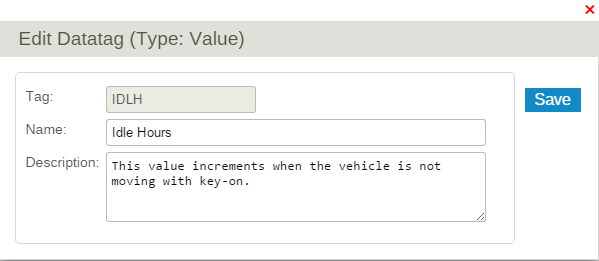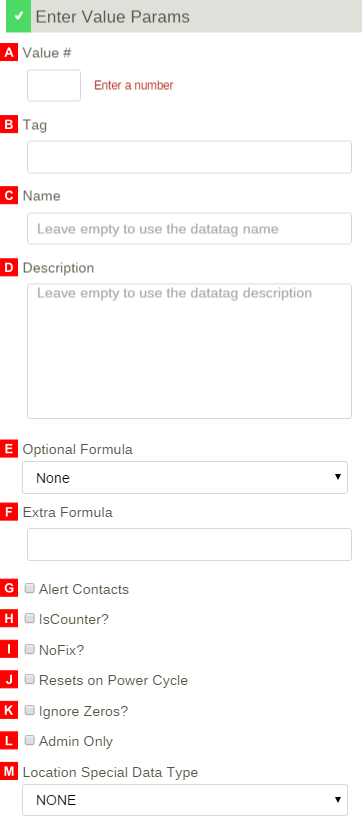Difference between revisions of "Templates"
imported>Dpltech (→Templates) |
imported>Dpltech (→Templates) |
||
| Line 23: | Line 23: | ||
:Click the green check mark to save or or red X buttons to cancel changes. The red trash icon on the far right deletes the row. | :Click the green check mark to save or or red X buttons to cancel changes. The red trash icon on the far right deletes the row. | ||
;G. Swap Parameter Position Icon: Changes the display position of parameters on the equipment management page. | ;G. Swap Parameter Position Icon: Changes the display position of parameters on the equipment management page. | ||
| − | ;H. Edit Datatag: Datatags | + | ;H. Edit Datatag: Datatags have names and descriptions that are used when the name and description is left empty on a row. Datatag names and descriptions are company wide. Changing them changes the name on all rows that don't have their own name and description and that use the datatag. Datatag names have been pre-populated with the most common names from the rows that were using those datatags. |
:[[File:DatatagManagement.png]] | :[[File:DatatagManagement.png]] | ||
Revision as of 13:33, 10 June 2015
__NOTITLE__
Templates
Templates allow you to define which set of parameters the device will listen for and report on. This includes; Values, Alarms, Locations and Actions.
To navigate to the Templates section, under Admin, select Templates.
This will display all available templates that you have created. To configure/edit any of the existing templates, click the Config button next the to template you wish to modify.
- A. Modify Button
- This will allow you to change values such as the templates' name, description, datatag, etc. Click on the green check mark to save your changes or the red X to cancel.
- B. Messaging(Alert Contact)
- If this check box is unchecked, the system will ignore the 'Alert Contact' check box of child parameters and a user won't get any email alerts.
- C. App Class
- The type of application the equipment is used for. This determines which mobile app the device is visible in (Currently: amslink, atmlink, and boatlink).
- D. Toggle View Button
- Switch the view to Tab view or Stacked view.
- E. Expandable Menu
- Add new rows from here.
- F. Edit Parameter Icon
- Puts a row in edit mode.

- Click the green check mark to save or or red X buttons to cancel changes. The red trash icon on the far right deletes the row.
- G. Swap Parameter Position Icon
- Changes the display position of parameters on the equipment management page.
- H. Edit Datatag
- Datatags have names and descriptions that are used when the name and description is left empty on a row. Datatag names and descriptions are company wide. Changing them changes the name on all rows that don't have their own name and description and that use the datatag. Datatag names have been pre-populated with the most common names from the rows that were using those datatags.

Values
In order to add a Value Parameter, click the New button from the expandable menu of the Values tab.This brings you to the Enter Value Params screen as below.
You have a number of configurable options you can set:
- A. Value #
- The corresponding number that you wish to reference.
- B. Name
- Leave empty to use the datatag name.
- C. Tag
- A datatag. Only allows the uppercase alphabets, number, '_' or '%'.
- D. Description
- Leave empty to use the datatag description.
- E. Optional Formula
- Pre-defined formulas to convert the raw data to a particular unit.
- F. Extra Formula
- Exactly as said, add a extra formula. When there is a optional formula, the extra formula will be added after executing the optional formula.
- G. Alert Contact
- If you would like the contact assigned to the device to be notified.
- H. IsCounter
- If you would like the value to increment on each time it gets triggered.
- I. No Fix
- The data won't be reset to zero on data reset. For furthur details, see Fix Data.
- J. Use Formula to enter initial value
- Exactly as said, utilizes a formula for the initial value.
- K. Resets on Power Cycle
- Exactly as said, the data will be reset on power cycle if this is checked.
- L. Ignore Zeros
- M. Admin Only
- N. Location Special Data Type
Alarms
In order to add an Alarm Parameter, click the New button from the expandable menu of the Alarms tab. This brings you to the Enter Alarm Parameter screen. Enter the corresponding number(#) that you wish to reference and provide a name for your new alarm parameter. Select the 'Alert Contact' check box if you want to alert the contact when the parameter is triggered, provide the new Value param with a Datatag and description, choose display level and alarm level and you're done!
Locations
In order to add a Location Parameter, click the New button from the expandable menu of the Locations tab. This brings you to the Enter Location Parameters screen. Enter the corresponding number(#) that you wish to reference and provide a name for your new location parameter Select the 'Alert Contact' check box if you want to alert the contact when the parameter is triggered, provide the new value param with a datatag and description and you're done!
Actions
In order to add a Action Parameter, click the New button from the expandable menu of the Actions tab. This brings you to the Enter Action Parameters screen. Enter the corresponding number(#) that you wish to reference and provide a name for your new action parameter. Select the 'Alert Contact' check box if you want to alert the contact when the parameter is triggered, provide the new action parameter with a datatag and description and you're done!
Settings
In order to add a Setting Parameter, click the New Setting button from the expandable menu of the Setting tab. This brings you to the Enter Setting Parameters screen. Provide a name and description and you're done!

